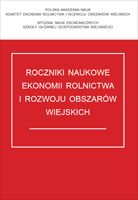Main Article Content
Article Details
Augustyńska-Grzymek I., Goraj L., Jarka S., Pokrzywa T., Skarżyńska A. 2000: Metodyka liczenia nadwyżki bezpośredniej i zasady typologii gospodarstw rolniczych. FAPA, Warszawa.
Czerwińska-Kayzer D. 2001: Rola inwestycyjnych kredytów preferencyjnych w przemianach strukturalnych rolnictwa indywidualnego. Zagadnienia Ekonomiki Rolnej, nr 6.
Daniłowska A: 2005: Kredyt rolniczy w Polsce w warunkach członkostwa w Unii Europejskiej. Prace Naukowe AE Wrocław, nr 1070, t. 1, 143-148.
Goraj L. 2006: FADN patrzy na gospodarstwa. Top Agrar Polska, s.22-25.
Karwat-Woźniak B. 2003: Inwestycje w gospodarstwach rozwojowych. Zagadnienia Ekonomiki Rolnej, nr 1.
Kulawik J. 2003: Kredytowanie i opodatkowanie rolnictwa oraz ubezpieczenia rolnicze. [W]: Analiza produkcyjno-ekonomicznej sytuacji rolnictwa i gospodarki żywnościowej w 2002 roku. IERiGŻ, Warszawa, s.76-77.
Mańko S 2001: Analiza finansowa gospodarstwa rolniczego. Program Leonardo da Vinci. ODR Minikowo, s.58-60.
Mańko S., Sass R. 2002: Sytuacja ekonomiczna gospodarstw korzystających z linii kredytowej MR w regionie kujawsko-pomorskim w latach 1998-2000. [W:] Gospodarstwa młodych rolników w warunkach integracji europejskiej. Uniwersytet Warmińsko-Mazurski, Olsztyn, s.83, 97-98.
Mańko S., Sass R., Sobczyński T. 2005a: Organizacja i wyniki gospodarstw bydlęcych i trzodowych. Prace Naukowe AE Wrocław, nr 1070, t. 2, 67-74.
Mańko S., Sass R., Sobczyński T. 2005b: Rentowność wybranych typów rolniczych gospodarstw w zależności od skali produkcji. Prace Wydziału Nauk Przyrodniczych. Seria B, nr 58. Bydgoskie Towarzystwo Naukowe, Bydgoszcz, s. 308-315.
Seremak-Bulge J., Hryszko K. 2005: Zmiany krajowej podaży mleka i przetworów. [W]: Rozwój rynku mleczarskiego i zmiany jego funkcjonowania w latach 1990-2005. IERiGŻ-PIB, Warszawa, s. 54-59.
Seremak-Bulge J., Pieniążek K. 2005: Zmiany struktur produkcyjnych. [W]: Rozwój rynku mleczarskiego i zmiany jego funkcjonowania w latach 1990-2005. IERiGŻ-PIB, Warszawa, s. 102-107.
Woś A. 2003: Rolnictwo i sektor żywnościowy w 2002 roku. IERiGŻ, Warszawa, s. 13.
Downloads
- Henryk Runowski, Theoretical and practical aspects of milk quota trading in agricultural holdings , Annals of Agricultural Economics and Rural Development: Vol. 93 No. 1 (2006)
You may also start an advanced similarity search for this article.
- Roman Sass, Herd size and the income from management in farms specialized in dairy production , Annals of Agricultural Economics and Rural Development: Vol. 93 No. 2 (2007)
- Roman Sass, Polish milk farms against a background of member states UE-15 , Annals of Agricultural Economics and Rural Development: Vol. 96 No. 3 (2009)
- Roman Sass, Production and incomes of farms in the Kujavian-Pomeranian province after Poland’s accession to the European Union , Annals of Agricultural Economics and Rural Development: Vol. 97 No. 3 (2010)




